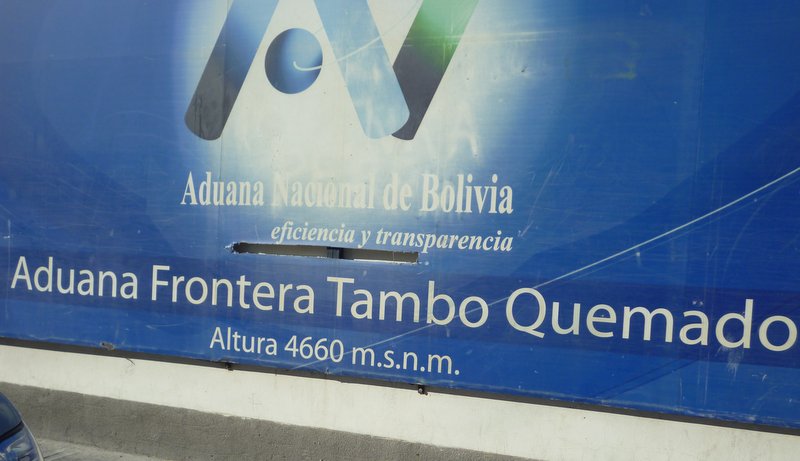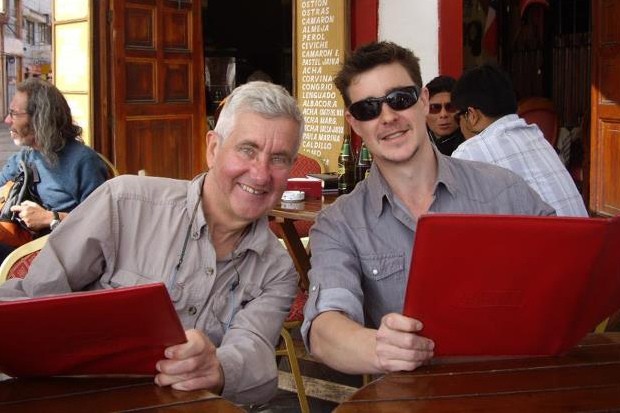Chile (North)
I hadnt done much research into my route from Bolivia to Arica on the Chilean coast due to the lack of WiFi and not meeting any travellers coming in the opposite direction. I knew the route was paved which is why I chose it but beyond that I only had my maps to rely on and maps for this part of the world tend to have various inaccuracies for one reason or another. I was planning on heading north on the Pan Americana Highway from Oruro to Patacamaya then turning west onto highway 108 which becomes highway 11 at the Chilean border. I hoped to stay in one of the villages along highway 108 that were shown on my map ready to tackle the border the following morning.
Nick and I In Oruru On The First Visit (Photo By Fletch)
It was bitterly cold through the night in Oruro so the following morning I took my time packing up the bike to allow the day to warm up somewhat. I was ready to leave at 10am but the hotel owner had gone out carrying the door keys with him so I couldnt get the bike out of the courtyard. I had stayed at the hotel before and the middle aged couple running it were very helpful. This time the woman was absent and the man was concentrating on his drinking more than running the hotel. There was nothing I could do but sit in an unheated draughty room and wait. The owner returned at 11am and without any apology for delaying me unlocked the door. Unusually it was still cold as I threaded my way through the city traffic, by late morning it was normally quite warm. Turning west towards the Pacific coast at Patacamaya I was looking forward to going downhill to some warmer weather but the road stayed at around 4000 metres then started climbing up towards the snowline which became closer with every kilometre.

The Day Got Colder And The Snowline Got Closer
The villages where I hoped to find accommodation either didnt exist or were down dirt side roads so I pushed on expecting to start heading downhill to warmer weather over the crest of every hill. At 4pm I arrived at the border post which was in the middle of nowhere at 4660 metres (15,145 feet), no wonder it was cold! For the next two and a half hours I was shuffled from one freezing outdoor queue to another while my paperwork was being processed. There were pink flamingos, the first wild ones I had ever seen, in a half frozen lake and some stunning snow capped mountain scenery but I was too cold to admire them or think about pausing to take photographs. The Chilean customs staff were asking about my trip and how far I intended to travel that day. I said it was now too late to get to Arica so I would be stopping at the next hotel. They didnt tell me that the next hotel would be in Arica, 200km (125 miles) away!

A Bitterly Cold Bolivia / Chile Border At 4660 Metres (15,145 Feet)
It was starting to get dark as I left the border and as luck would have it there were some roadworks which meant delays for one way traffic leaving me sitting on a stationary motorcycle in sub zero temperatures then riding slippery dirt sections of road in the fading light. Eventually I was clear of the roadworks and with the luxury of having reflective markers identifying the edges and centre of the Chilean road I pushed on in the dark. At last the road started going downhill, the temperature gradually got warmer and I finally arrived at an Arica hotel at 9:30pm having ridden 347 miles (555 kilometres) from Oruro.

Arica, Northern Chile
Chile brought on the first attack of culture shock on the trip. Travellers had said that Chile and Argentina were more like western countries and I had been looking forward to the contrast although not the increase in prices. Throughout Latin America the vast majority of motorbikes had been small machines used to take produce to and from the market, delivering bottles of gas and just about anything else you could think of through the week. At weekends they would be used to take the family (of up to five although the fifth had to be a newborn baby to fit) out visiting. In Chile I only saw larger bikes owned by enthusiasts as you do in Europe and North America. There was no continuous unnecessary beeping of car horns, no triple parked buses or buses stopping in the middle of junctions to pick up or let off passengers. The most disturbing thing was vehicles stopping at pedestrian crossings, totally unexpected and somewhat unnerving. Why? Is the driver trying to lure unsuspecting pedestrians off the kerb before accelerating towards them? It took awhile before I got used to the courteous behaviour of the Chilean drivers.
I expected the Chilean coast to be hot as I was still in the tropics but as it was midwinter and a coastal sea fog partially screened the sun it was necessary to wear two or sometimes three layers of clothing even in the afternoons. Certainly not cold but a long way from tropical. Iquique my next stop a bit further south was a few degrees cooler still.

Coastal Sea Fog Helped To Keep The Temperature Down
I was looking for a warm place with enough entertainment to keep me occupied while I waited for the temperature to increase on the passes to northern Argentina. Both the Jama and Sico passes east of San Pedro de Atacama were closed by snow while I was on the coast although the Jama pass that I intended to take was quickly reopened.
If it wasnt hot at least it wasnt raining, the Atacama Desert is the driest place on earth. Some weather stations have never recorded a drop of rain since they were opened and some of the river beds have been dry for at least 120,000 years. NASA used the Atacama Desert to test and develop instruments for the Viking Mars missions and subsequently found the soil of Mars and the Atacama Desert to be very similar.
One of the adventure sports on offer in Iquique is throwing yourself off a cliff top with a parachutist strapped to your back. If everything works as it should, and fortunately it did on the dozen or saw times I was watching you gently float down onto the beach still connected to your parachutist.

Another Safe Landing
I had arranged to meet my Australian nephew, Jamie in Iquique. He had been skiing in Portillo, not far from Santiago, Chile with a bunch of his mates and was then backpacking towards Cusco in Peru to hike the Inca Trail. I hadnt seen him since he was about ten years old and he had changed considerably in the intervening years. Most alarmingly, he had shot up from coming up to my waist to towering above me all in the space of a mere fifteen years or so.
When we met; he was undecided whether to spend several more months backpacking around South America after hiking the Inca Trail or heading back to work in Australia and putting the money saved towards buying a motorbike to replace the one he sold to finance his South American trip. A difficult decision.

Jamie and Myself (Jamie Is The One On The Right Just In Case There Was Any Confusion)

If A Big Wave Comes You Must Run In Which Direction?
It was a good scenic ride along the coast from Iquique to Tocopilla then headed inland to Calama. Once I left the coast and gained some altitude the daytime temperatures increased although it would hover either side of freezing through the night. I camped in Calama, wearing as many layers of clothes I could get on while I slept and managed to stay warm.
I had been trying to get motorcycle third party insurance for Argentina, Paraguay, Brazil and Uruguay at each city I came to but was always told the same thing, they can only supply insurance for vehicles with Chilean registration plates. I guess this is because of the introduction of a computer system used to validate the vehicle and its owner which doesnt recognise foreign licence plates. In Calama I went to the same office where someone I knew had got motorcycle insurance a few months previously but was told they could only insure Chilean bikes now. I had read about other travellers not finding insurance in some of the Latin American countries to the north of Chile and Argentina but I never had a problem the general rule being if insurance is compulsory it will be available at the border. I never anticipated problems in the more westernised countries of Chile, Argentina etc.

Calama To San Pedro de Atacama
My final destination in northern Chile was San Pedro de Atacama which is at a slightly higher elevation than Calama and as there was a strong cold wind blowing for most of the journey I was undecided whether to camp or stay in a hostel. I expected it to be colder than Calama at night and wasnt sure how well I would sleep. I went to the campsite first and as I got off the bike someone came over to see if he could help. This turned out to be Hutch a seventy two year old Californian who has spent the last seven years cycling around the world. He was camping so I decided to join him. Hutch plans on cycling for another year and his tales were truly inspirational.

Hutch On The Right On Year Seven Of Cycling Around The World

